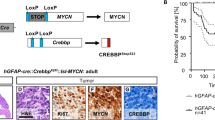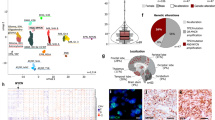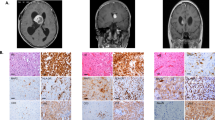Abstract
Astrocytomas are the leading cause of brain cancer in humans. Because these tumours are highly infiltrative, current treatments that rely on targeting the tumour mass are often ineffective. A mouse model for astrocytoma would be a powerful tool for dissecting tumour progression and testing therapeutics. Mouse models of astrocytoma have been designed to express oncogenic proteins in astrocytes, but have had limited success due to low tumour penetrance or limited tumour progression1,2,3. We present here a mouse model of astrocytomas involving mutation of two tumour-suppressor genes, Nf1 and Trp53. Humans with mutations in NF1 develop neurofibromatosis type I (NF1) and have increased risk of optic gliomas, astrocytomas and glioblastomas4,5. The TP53 tumour suppressor is often mutated in a subset of astrocytomas that develop at a young age and progress slowly to glioblastoma (termed secondary glioblastomas, in contrast to primary glioblastomas that develop rapidly de novo6,7,8,9,10). This mouse model shows a range of astrocytoma stages, from low-grade astrocytoma to glioblastoma multiforme, and may accurately model human secondary glioblastoma involving TP53 loss. This is the first reported mouse model of astrocytoma initiated by loss of tumour suppressors, rather than overexpression of transgenic oncogenes.
This is a preview of subscription content, access via your institution
Access options
Subscribe to this journal
Receive 12 print issues and online access
$209.00 per year
only $17.42 per issue
Buy this article
- Purchase on Springer Link
- Instant access to full article PDF
Prices may be subject to local taxes which are calculated during checkout






Similar content being viewed by others

References
Danks, R. et al. Transformation of astrocytes in transgenic mice expressing SV40 T antigen under the transcriptional control of the glial fibrillary acidic protein promoter. Cancer Res. 55, 4302–4310 (1995).
Holland, E., Hively, W., DePinho, R. & Varmus, H. A constitutively active epidermal growth factor receptor cooperates with disruption of G1 cell-cycle arrest pathways to induce glioma-like lesions in mice. Genes Dev. 12, 3675–3685 (1998).
Weissenberger, J. et al. Development and malignant progression of astrocytomas in GFAP-v-src transgenic mice. Oncogene 14, 2005–2013 (1997).
Huson, S. & Hughes, R. The Neurofibromatoses: A Pathogenetic and Clinical Overview (Chapman & Hall Medical, London, 1994).
Sorensen, S.A., Mulvihill, J.J. & Nielsen, A. Long-term follow-up of von Recklinghausen neurofibromatosis. Survival and malignant neoplasms. N. Engl. J. Med. 314, 1010–1015 (1986).
Watanabe, K. et al. Incidence and timing of p53 mutations during astrocytoma progression in patients with multiple biopsies. Clin. Cancer Res. 3, 523–530 (1997).
Watanabe, K. et al. Overexpression of the EGF receptor and p53 mutations are mutually exclusive in the evolution of primary and secondary glioblastomas. Brain Pathol. 6, 217–223 (1996).
van Meyel, D.J. et al. p53 mutation, expression, and DNA ploidy in evolving gliomas: evidence for two pathways of progression. J. Natl Cancer Inst. 86, 1011–1017 (1994).
Rasheed, B.K. et al. Alterations of the TP53 gene in human gliomas. Cancer Res. 54, 1324–1330 (1994).
Lang, F.F., Miller, D.C., Koslow, M. & Newcomb, E.W. Pathways leading to glioblastoma multiforme: a molecular analysis of genetic alterations in 65 astrocytic tumors. J. Neurosurg. 81, 427–436 (1994).
Cichowski, K. et al. Mouse models of tumor development in neurofibromatosis type I. Science 286, 2172–2176 (1999).
Vogel, K. et al. Mouse tumor model for neurofibromatosis type 1. Science 286, 2176–2179 (1999).
Rizvi, T. et al. Region-specific astrogliosis in brains of mice heterozygous for mutations in the neurofibromatosis type 1 (Nf1) tumor suppressor. Brain Res. 816, 111–123 (1999).
Gutmann, D. et al. Haploinsufficiency for the neurofibromatosis 1 (NF1) tumor suppressor results in increased astrocyte proliferation. Oncogene 18, 4450–4459 (1999).
Tischler, A., Shih, T., Williams, B. & Jacks, T. Characterization of pheochromocytomas in a mouse strain with a targeted disruptive mutation of the neurofibromatosis gene Nf1. Endocrine Pathol. 6, 323–335 (1995).
Kleihues, P. & Cavenee, W. Pathology and Genetics of Tumours of the Nervous System (International Agency for Research on Cancer, Lyon, 1997).
Kleihues, P., Burger, P.C. & Scheithauer, B.W. The new WHO classification of brain tumours. Brain Pathol. 3, 255–268 (1993).
Scherer, H. The forms of growth in gliomas and their practical significance. Brain 63, 1–35 (1940).
Marsden, H.B., Kumar, S., Kahn, J. & Anderton, B.J. A study of glial fibrillary acidic protein (GFAP) in childhood brain tumours. Int. J. Cancer 31, 439–445 (1983).
Gould, V.E. et al. Synaptophysin: a novel marker for neurons, certain neuroendocrine cells, and their neoplasms. Hum. Pathol. 17, 979–983 (1986).
Bonner, R. et al. Laser capture microdissection: molecular analysis of tissue. Science 278, 1481–1483 (1997).
Easton, D., Ponder, M., Huson, S. & Ponder, B. An analysis of variation in expression of neurofibromatosis (NF) type 1 (NF1): evidence for modifying genes. Am. J. Hum. Genet. 53, 305–313 (1993).
Jacks, T. Tumor predisposition in mice heterozygous for a targeted mutation in Nf1. Nature Genet. 7, 353–361 (1994).
Menon, A. et al. Chromosome 17p deletions and p53 gene mutations associated with the formation of malignant neurofibrosarcomas in von Recklinghausen neurofibromatosis. Proc. Natl Acad. Sci. USA 87, 5435–5439 (1990).
Jacks, T. Tumor spectrum analysis in p53-mutant mice. Curr. Biol. 4, 1–7 (1994).
Lowe, S., Jacks, T., Housman, D. & Ruley, H. Abrogation of oncogene-associated apoptosis allows transformation of p53-deficient cells. Proc. Natl Acad. Sci. USA 91, 2026–2030 (1994).
Brugarolas, J., Bronson, R. & Jacks, T. p21 is a critical CDK2 regulator essential for proliferation control in Rb-deficient cells. J. Cell Biol. 141, 503–514 (1998).
Acknowledgements
We thank D. Crowley, N.H. Fong, K. Mercer and B. Williams for technical assistance; A. Charest, J. Sage, K. Cichowski, K. Olive, K. Johnson, K. Tsai and D. Tuveson for discussions; C. Whittaker, C. Fry, M. Bryce and J. Reilly for assistance in preparation of the manuscript and figures; and S. Shih for assistance with inbreeding of Nf1+/− mice. K.M.R. is supported by a post-doctoral fellowship from the Leukemia & Lymphoma Society. T.J. is an Associate Investigator of the Howard Hughes Medical Institute. This work was supported in part by a grant from the Department of the Army and the Medallion Foundation.
Author information
Authors and Affiliations
Corresponding author
Supplementary information
Table 1
Tumor phenotype of NPcis mice (XLS 40 kb)
The table summarizes for the mice in this study the sex; strain background (background); generation (gen); age at time of death (age); description of tumor histology as scored by atypical nuclei (AN), mitotic figures (M), presence of a focal tumor (FT), necrosis (N), excessive or aberrant blood vessels (V), multinucleated giant cells (GC), and spread to the leptomeninges (LM); grade of tumor based on the grading criteria described in figure 6 legend (grade); immunoreactivity for GFAP, synaptophysin (SNPN), and nestin; the number of days the animal was monitored from the time it was noticed to be sick to the time of sacrifice (days to sac); the observations at the time of sacrifice (reason for sacrifice); whether other tumor types were present (other tumors); and location of tumor (location). The age of the mice is given in months. Immunoreactivity for GFAP is indicated by "+++" for widespread staining of tumor cells, "++" for staining of sparse tumor cells within the tumor, "+" for cells staining within the tumor that could not be distinguished from reactive astrocytes. Tumors scored "+" for GFAP may contain positive staining tumor cells; however, the morphology of the stained cells did not allow us to determine whether the cells were tumor cells or normal cells. Immunoreactivity for synaptophysin is indicated by "-" for no positive cells within the tumor and "+/-" for tumors showing staining of normal neurons within the region of the tumor. These tumors were located in the olfactory bulb or pons and had invaded regions of dense neuronal processes. No tumor showed immunoreactivity for nestin. It should be noted that for the purposes of this study any mouse showing signs of neurological impairment was sacrificed immediately; therefore the days to sacrifice cannot be taken as a measure of brain tumor progression. The mice that were followed for long periods of time showed slow growing, externally visible soft tissue sarcomas. The mice listed under Laser Captured Samples and Additional Tumor Cell Line Samples were not from the same sibling set as the mice in the upper section of the table. They were not included in the calculation of penetrance of the phenotype or in the percentage of tumors immunoreative for GFAP. Cell lines were also generated from KR158 (B6) and KR130 (SXB6). Within each strain group the mice are listed in order from youngest at time of death to oldest. The B6, HXB6, and SXB6 all show a clear trend towards higher grade tumors in older mice and 90-100% penetrance of brain tumors after 6 months of age.
Rights and permissions
About this article
Cite this article
Reilly, K., Loisel, D., Bronson, R. et al. Nf1;Trp53 mutant mice develop glioblastoma with evidence of strain-specific effects. Nat Genet 26, 109–113 (2000). https://doi.org/10.1038/79075
Received:
Accepted:
Issue Date:
DOI: https://doi.org/10.1038/79075
This article is cited by
-
CRISPR-Switch regulates sgRNA activity by Cre recombination for sequential editing of two loci
Nature Communications (2019)
-
Lin−CCR2+ hematopoietic stem and progenitor cells overcome resistance to PD-1 blockade
Nature Communications (2018)
-
Oxaliplatin disrupts pathological features of glioma cells and associated macrophages independent of apoptosis induction
Journal of Neuro-Oncology (2018)
-
AAV-mediated direct in vivo CRISPR screen identifies functional suppressors in glioblastoma
Nature Neuroscience (2017)
-
The molecular and cell biology of pediatric low-grade gliomas
Oncogene (2014)


